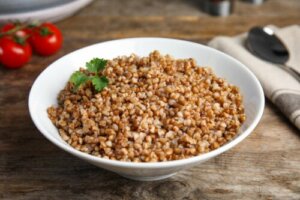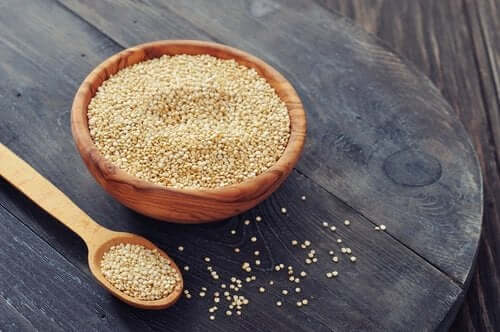What Are Pseudocereals and What Are the Benefits?


Written and verified by the nutritionist Anna Vilarrasa
Pseudocereals are plants that people have been cultivating for years. This grain is actually a flower seed. Whereas typical cereals and grains, on the other hand, are the fruit of the plant. Keep reading to discover the benefits of pseudocereals!
Despite this difference, their nutritional level classification is in the same group as typical cereal. Their percentages can vary a little, but their macronutrient content (carbohydrates, proteins, and lipids) are similar.
Varieties of pseudocereals
There’s a large variety of pseudocereals. However, among the most common we can find the following:
- Buckwheat (Fagopyrum esculentum): This is from Central Asia and it comes in the curious shape of a pyramid, or a little triangle. It’s rich in minerals that the body can absorb easily. Specifically, it provides us with rutin, a potent antioxidant that protects blood vessel integrity and prevents blood clots from forming.
- Quinoa (Chenopodium quinoa Willd): This is an Andean plant that adapts very well to different climatic conditions and types of soil. Its nutritional composition is very rich and it has caught the attention of the scientific community. In fact, WHO dubbed 2013 as the International Year of Quinoa.
- Amaranth (Amaranthus cruentus L): Amaranth is surely the least well-known out of the three. With origins in Central and South America, it comes in the form of grains between 3/10 of an inch and 3/5 of an inch. Out of the three pseudocereals, this has the most intense flavor. Many people prefer to start mixing this with rice or millet to get used to it bit by bit.

The benefits of pseudocereals
As we’ve already mentioned, pseudocereals have a very good nutritional composition. They provide proteins, carbohydrates, healthy lipids, fiber, vitamins, and minerals. Thanks to that, they also provide some advantages and important benefits for our health.
Within the framework of a balanced, varied, and sufficient diet, you can introduce pseudocereals regularly, although it’s not necessary to transition to eating them exclusively, especially if they’re not in your usual diet because then your consumption stops being sustainable.
Read more: Quinoa Risotto With Mushrooms, Chicken and Leaks
Suitable for celiacs
Quinoa, buckwheat, and amaranth don’t contain gluten. They’re a good alternative to rice and millet, both for improving the variety of the gluten-free diet as well as for making pasta or bread. Also, they’re easy to digest and can even benefit many people who don’t have celiac disease but aren’t satisfied with gluten.
A good option for vegans
Both amaranth and quinoa are an excellent source of vegetable protein since they provide us with all the essential amino acids in suitable quantities. The same doesn’t happen with buckwheat, but we can supplement this with seeds, legumes, or nuts throughout the day.
Nutritious and energetic
Foods rich in carbohydrates are an excellent source of energy. For that reason, they’re essential for people who endure great physical wear, such as athletes. They can also help in intellectual performance, or rather, for people who are recovering after an illness, trying to regain their physical state.
Source of micronutrients
We can find almost all pseudocereals in their entire form. They contribute to our good state of overall health, as they contain fiber, vitamins, and minerals. Also, their glycemic index is low, which avoids high glucose spikes after you eat them.
They contain phytochemicals
Pseudocereals have caught the attention of scientists because they’re very rich in phytonutrients. These have anti-inflammatory and anti-oxidant activity. The conclusion of some studies is as follows:
“They can contribute to reducing the risk of oxidative stress related to some illnesses like cancer, obesity, cardiovascular problems, or diabetes”.
Discover more: Phytochemicals in Food: What Are They?
How can you consume pseudocereals?
Pseudocereals have a lot of versatility in the kitchen, just like cereals and grains. Nowadays it’s becoming easier to find them, not just in their whole form, but also dried, in pasta, flour, or having been soaked in water. Also, the flour is great for making bread and gluten-free pasta.
Cooking these is very similar to cooking rice, oats, or barley grain. Before cooking them, wash them with a bit of water. After that, boil them with double the volume of water. In 20 or 25 minutes, they’ll be ready. You don’t even need to soak them first!
Some potential recipes are as follows:
- A variety of recipes like vegetable paellas: stir-frys, on their own with tomato sauce, in salads, or as a filling for eggplants, are some good options.
- Oatmeal and muesli for breakfast, which you can make with dried pseudocereals or those that have been soaked in water. Try mixing them with cinnamon or cocoa, raisins, nuts, or fruit. You can even soften it with yogurt, cow’s milk, or vegetable drinks.
- You can make sweet treats with the flour like the typical Breton galettes that traditionally require buckwheat flour. And, why not try to make your own bread or pizza dough?
Overall, pseudocereals are foods that you can incorporate into your diet to obtain nutrients that benefit your health. They’re versatile, gluten-free and you can use them in many traditional recipes.
All cited sources were thoroughly reviewed by our team to ensure their quality, reliability, currency, and validity. The bibliography of this article was considered reliable and of academic or scientific accuracy.
- Filho AM, et al.Quinoa: Nutritional, functional, and antinutritional aspects. Critical reviews in food science and nutrition. Mayo 2017. 24; 57(8):1618-1630.
- McGee H. La cocina y los alimentos. Enciclopedia de la ciencia y la cultura de la comida. Random House Mondadori. Enero 2008.
- Tang Y, Tsao R. Phytochemicals in quinoa and amaranth grains and their antioxidant, anti-inflammatory, and potential health beneficial effects: a review. Molecular nutrition and Food research. Julio 2017. 61(7).
This text is provided for informational purposes only and does not replace consultation with a professional. If in doubt, consult your specialist.








